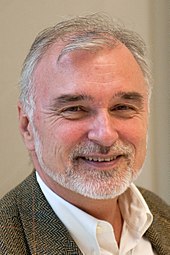Ernst Pernicka
Ernst Pernicka [ˈpɛʁnɪtska] (born February 5, 1950 in Vienna ) is an Austrian chemist specializing in archaeometry .
Life
Ernst Pernicka grew up in Vienna and attended elementary school and high school there.
education
From 1968 Pernicka studied chemistry at the University of Vienna , where he received his doctorate in 1976 with a thesis on the manufacturing technology of medieval glazed ceramics from Persia and Afghanistan . With a thesis on ore deposits in the Aegean Sea , he completed his habilitation in 1987 at the Faculty of Geosciences at the Ruprecht-Karls-Universität Heidelberg .
career path
In Vienna from 1973 to 1976 he worked as a research assistant at the Institute for Analytical Chemistry (electron beam microprobe, neutron activation analysis). In 1976/77 he was a research assistant at the Max Planck Institute for Nuclear Physics . Thematically it was about archaeometallurgy, to elucidate the origin of the silver for ancient coinage. He worked as a research assistant at the Institute for Analytical Chemistry at the University of Vienna from 1977 to 1979 and returned to the Max Planck Institute for Nuclear Physics in Heidelberg in 1979 as a research group leader (chemistry). Up until 1997, it was about the origin and spread of metallurgy in the Old World, determining the origin of ceramics and obsidian in the eastern Mediterranean (especially in Troy ). The analytical methods used included
- Neutron activation analysis,
- X-ray fluorescence analysis,
- X-ray diffraction,
- Atomic absorption spectrometry,
- Ion chromatography,
- UV / VIS photometry,
- Gravimetry and
- Titrimetry.
In 1997 he accepted a professorship for archaeometallurgy at the TU Bergakademie Freiberg / Saxony and worked there for seven years. From 2004 to 2013 he was Professor of Archaeometry / Archaeometallurgy at the Institute for Prehistory and Early History and Archeology of the Middle Ages at the Eberhard Karls University in Tübingen . At the same time he was scientific director and managing director of the Curt-Engelhorn-Zentrum Archäometrie gGmbH, Mannheim (affiliated institute of the University of Tübingen). Scientific work areas were u. a. isotope archeology and authenticity testing of archaeological finds. Since 2013, Pernicka has been endowed professor for archaeometry at the Klaus Tschira Foundation at the Institute for Geosciences at Heidelberg University and scientific director and managing director of the Curt Engelhorn Center for Archaeometry in Mannheim.
Scientific work
His research area is in particular the development and application of scientific methods in archeology as well as the emergence and spread of metallurgy in the ancient world . He is involved in research on the Nebra Sky Disc as well as in Troy and Iran. Since 2013 he has expressed doubts about the authenticity of the gold finds by Bernstorf .
From 2006 to 2012 he was Manfred Korfmann's successor, head of the excavation in Troy, and at times also in Udabno ( Kakheti / Eastern Georgia).
Prices
- 2007: Science Prize of the State of Vorarlberg (Austria), together with R. Krause and K. Oeggl.
- 2012: Election to the corresponding member abroad of the mathematical-scientific class of the Austrian Academy of Sciences.
- 2013: Advanced Grant of the European Research Council , the most valuable research grant from the EU for outstanding achievements.
literature
Web links
- Literature by and about Ernst Pernicka in the catalog of the German National Library
- Ernst Pernicka in the Internet Movie Database (English)
- Homepage Heidelberg University
- Homepage University of Tübingen
- Gold Treasure from Bernstorf - Doubt
- Metalworking pioneers
- Publications
Individual evidence
- ↑ Ulf von Rauchhaupt : Pure gold . In: Frankfurter Allgemeine Sonntagszeitung No. 2/2017 of January 15, 2017, p. 57.
- ↑ ERC “Advanced Grants” for three scientists from the University of Tübingen ( page no longer available , search in web archives ) Info: The link was automatically marked as defective. Please check the link according to the instructions and then remove this notice. , Press release from the University of Tübingen, January 30, 2013.
| personal data | |
|---|---|
| SURNAME | Pernicka, Ernst |
| BRIEF DESCRIPTION | Austrian archaeometrist |
| DATE OF BIRTH | 5th February 1950 |
| PLACE OF BIRTH | Vienna |

